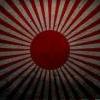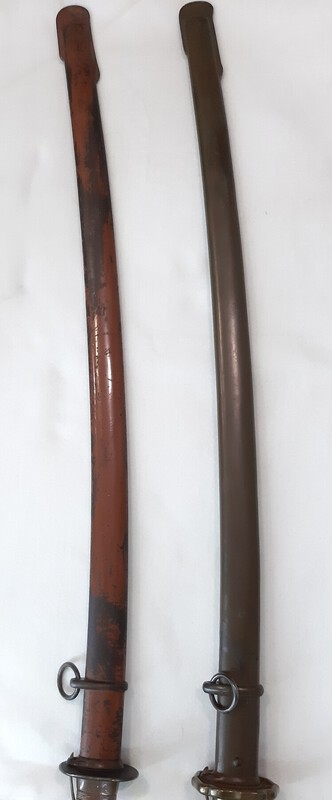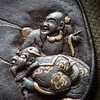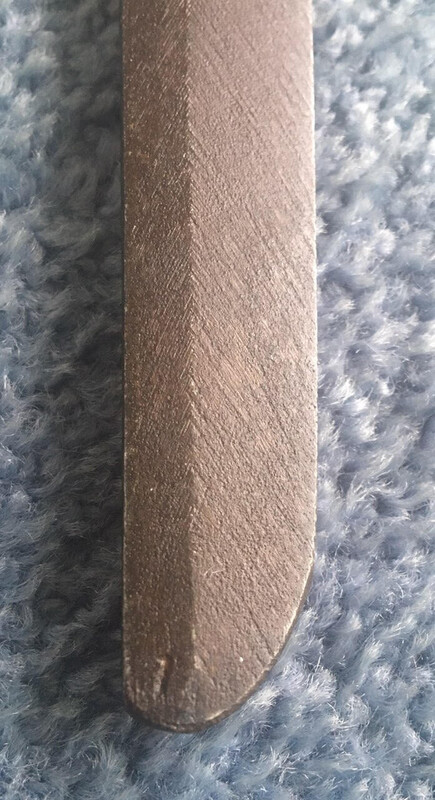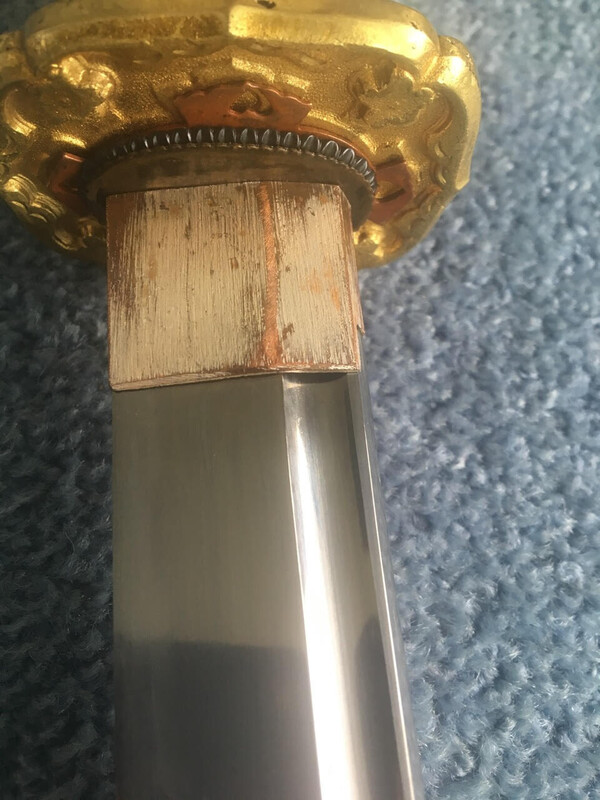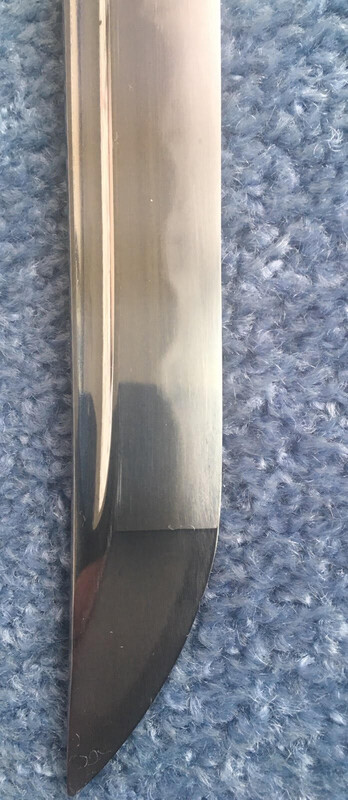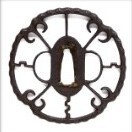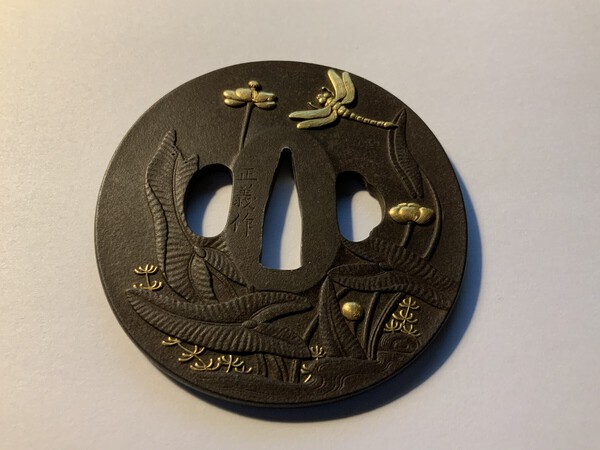Leaderboard
Popular Content
Showing content with the highest reputation on 03/21/2021 in all areas
-
5 points
-
Good find from Junk dealer, seems to be late Edo period tanto. Signature is - 近江国胤勝 - Ōmi no kuni Tanekatsu. This smith Tanekatsu was rather unknown but he studied under the famous Taikei Naotane. Age would be in the mid-later 1800's.3 points
-
文化十三年二月 應渡邊好禮需造之 - Responding to the order from Watanabe Yoshinori (reading?), made this.3 points
-
That Abe Nobuyuki did not have the title of Count. I found that Marquis Asano Nagakoto's younger brother was adapted into Abe family and became Count Abe Masatake. Ref. 阿部正桓 - Wikipedia3 points
-
2 points
-
Ha! I just had a thought - what if the nut is upside down? There is only one way to know..........2 points
-
Hello everyone, Just wanted to share a preview of a tsuba that I am photographing and writing about for my personal collection website: Tsuba Otaku | Reflections of a Not So Empty Mind. This tsuba is part of personal collection and not for sale therefore the propose of the is new topic is to just promote the education and learning of our shared hobby of collecting Japanese sword fittings. This is a Katchūshi (armorsmiths) tsuba from the collection of my late Japanese sword teacher Kunio Izuka of the New York Tōken Kai. It was purchased via auction from Bonham Auction House New York in Nov. 2020. More information about Kunio-sensei can be found here. I think it dates from the late Muromachi Period comparing it to similar tsuba I have had. I have found this tsuba published in a Japanese book about tsuba that I purchased from Grey Doffin years ago at the Tampa Japanese Sword and antiques show. My wife Tamaki is helping me with the translation of the few pages of this book regarding this tsuba and more information about the book itself. I will share more details on April 1st when I update my personal collection website. I find it interesting that the raised rim of the tsuba a separate piece of iron, feels hollow, and that plate of the tsuba retains much of the original black lacquer applied to the surface. This is more visible in the second photograph. This a small tsuba relatively speaking and likely made for a wakizashi and measures 7.4 cm wide by 7.6 cm high. Feel free to politely discuss and ask questions. Thank you for reading.2 points
-
Thanks for sharing the video. Just noticed that there is a second part here:2 points
-
https://studyingjapaneseswords.com/2018/03/17/20-nanboku-cho-tanto/ The photo in "Chapter 19 Nanboku-cho Period Tanto" was changed. Please click the link above to go to the chapter directly. I finished editing and correcting the draft and working to publish the book but I am having difficulty deciding which publisher suits me and how to go about. Vast information to go through. Creating a physical book is harder than writing. Yurie2 points
-
Too many questions to answer in one post, Peter, but all valid in their own right. An incredibly complex area that would be a fascinating read, if such a thing existed. Starting with a generality. It is my experience that conversions in Japan today are worth less than the matchlock upon which they were built. Some very beautiful and complicated conversions are rare and fascinating however, and may well be worth more. (Boso-Raika sliding pill-lock mechanism for example.) Of course it depends on the dealer and the customer/collector. Many collectors simply want an example of 'a Hinawa-Ju' matchlock, preferably with a Mon and/or some flashy Kirigane copper and brass decorations that they can polish and display somehow. Although a conversion will have added speed of loading and maybe extra firepower to a weapon, the gun will in the process have increased its killing power and lost some of its 'innocence', created as it was in a Golden Age (c1615-c1850) when war was not pressing urgently upon the shores of Japan, and gunnery had become a civilized Martial Art. It was clear that smoothbore muzzle-loading Hinawa-ju could no longer cut the mustard against breech-loading Western percussion, rim/pin-fire and cartridge rifles though. Without a strong central government, individual Han opened their coffers and employed agents to negotiate separately with traders or representatives of the various foreign powers to procure modernized weapons. This means that few records were kept as this was a largely secret trade. To match the sudden appearance of Western weapons from here and there, native gunsmiths had to learn how to adapt old weapons, or create new ones in parallel. Some Han (e.g. Kaga) issued orders and gathered up all available old matchlocks and either melted them down or converted them. Smiths that could not adapt continued to produce old style matchlocks which probably failed to sell. Some smiths learned how to make conversions of these; others how to imitate and create faithful copies of Western weapons. I do not think there is a market for converted weapons to be re-introduced into Japan, unless in very specific circumstances. Importing any kind of gun into Japan is a long drawn-out and tiring business, the whole system designed to wear down and discourage everyone involved. There is a consciousness among the trade of how a gun has been registered. If the card says 'percussion' system on it, for example, there is less incentive to change it back into a matchlock as that would be breaking the law. No alterations are legally allowed on registered weapons. (Taking a break here...)2 points
-
2 points
-
2 points
-
Hi Greg, Thanks for joining the thread. The Hallam tsuba was made around 2010 , if memory serves. Few more of his pieces to come... Regards2 points
-
2 points
-
False. The carbon is what is making the steel. The higher the carbon the more flexible and durable the steel. Simple basic science. @DoTanuki yokai And your knowledge is non-existent. Go bend your nihonto katana and cry im done. You linked me a video of nihonto smiths destroying katanas as proof they will stand up to modern steel. I linked you a video of a famous American smith explaining why youre naive and anothed video of high carbon steels being stress tested the same way as your nihonto and passing. At this point youre being willfully ignorant.2 points
-
All swords need to be tempered. Plus aesthetics. That choji hamon cost me an extra 100 bucks. Suguha would have been cheaper. I could have spent more for a more flamboyant one but I didn’t want to break the bank. The L6 is actually very difficult to work with and any fancier hamon he would have had to make the blade several times to get it right. It would have cost me 1700. He politely asked me not to make him do it as well when we were hammering out the details of the blade. When your buying from a Japanese smith your paying a huge amount for the Japanese laws regarding sword making. They can make three a month I thought it was less. They also have to do an unpaid apprenticeship. They also cannot use any modern methods or metals. Your paying for this extra hard work that is unnecessary with modern metals and equipment. About this video they are destroying nihonto katanas there my friend. Go look up someone doing this to modern 1060 or higher. I am speaking from personal experience. I have destroyed a modern nihonto in a stress test versus this katana. Thats right i said it i destroyed a modern nihonto. Hate me if you must. This L6 toolsteel took everything i threw at it and is perfect and healthy. Europeans did not develop differential hardening anywhere near the same way Japanese smiths did. They used hot tongs and interrupted quenching to achieve the desired flexibility and edge retention. They quench the blade and reheat the spine and quench it again. Japanese swords developed the more advanced hamon to give it a softer spine and harder edge. Thus making their design more flexible than they would have been able to achieve with the process and difficulty involved in separating higher and lower carbon iron. The whole process of making tamahagane is to add carbon to the extremely low carbon iron sand from rivers. As opposed to already high carbon iron mined out if the ground. Once the higher and lower carbon steels are folded the hamons purpose is to make the edge harder and better edge retentive while leaving the spine softer. You just dont need to do all this folding when starting with higher carbon steels. You do still need to temper. All of this technology was driven by necessity. Tamahagane by its very nature has MORE impurities than modern steel. The whole reason for folding the steel is to remove the impurities! You literally do not have to fold modern steel unless you just want to make the blade more traditional looking or prettier. It costs a little more and is entirely unnecessary. I paid extra because i was making something pretty with a hitatsura hamon( the one i just ordered not this one i pictured. ) You cannot fold L6 i am told for any price, they just wont do it. The sulfur in l6 bainite is what makes L6 bainite. Plus a little magnesium i think. Its an alloy and everything in that alloy is supposed to be there. For that matter all steel is an iron/carbon alloy. And to agree with you on one thing YES you’re entirely paying for artistic value. What i am describing is the difference between a ferari and an armored humvee. Yeah the ferari is super nice, very expensive, pretty with all the bells and whistles. Its super exclusive and you need to get in the waiting list for a new one. Who doesnt want a ferari if they had the chance? If you slam the ferari into the armored humvee you’re going to need a new ferari and the armored humvee is gonna keep on trucking. All modern nihinto are works of art to be cherished and appreciated, but if you want something to abuse you definitely dont want to buy that ferari unless you just have that kind of money. Ive already been admonished about this conversation and I honestly appreciate the fact that youre even listening to me and having this discussion. Please dont take me as being rude or derisive. You asked so Im trying to explain my point. Im not buying a crap fake like the ones you see here from time to time made to cheat someone, and thats the only reason i felt the need to say what I did that started this whole conversation between us. It is just a plain cold fact that modern steel and technology can produce a more durable sword than traditional nihonto smithing methods. If you have a problem understanding this i dont know how to better explain what is a simple truth. Your gonna have to buy a high quality modern sword and find out for yourself. @DoTanuki yokai To disagree with this is to disagree with SCIENCE.2 points
-
Here is my nice Tsuba by Masayoshi Masayoshi with the theme of dragonflies. The dragonfly in Japanese is tombo (蜻蛉) and in the Muromachi period kachimushi was its name (勝 虫). These characters for literally mean Victory Bug and gives us insight into how the bushi of the time admired the dragonfly. Bushi had observed the nature of the dragonfly to attack, and always move forward to the prey.1 point
-
I will definitely try it. I am out of town until Tuesday so I will have to wait until then to make attempt. As far as it protruding when I hold the sword, to be honest I didn’t pay too much attention as this was my first Type 95 I was just pumped to be holding it. Elco68 handle comes from my 1968 El Camino I am restoring. Thanks for all the help everyone-this forum is awesome!1 point
-
Awhile back someone was looking for a tsuba with basket weave. It may have been on FB on the outside chance it was here. For you. https://buyee.jp/item/yahoo/auction/s813797163?1 point
-
Jacques, Fujishiro does mention Go Yoshihiro (Koto volume page 129, page 199) but does not show any nakago as there are no signed Go, while his book is a book of nakago and mei. The reality is that shinsa judgment is broadly an assessment of school + period first and then after that, quality determines whether they assign it to a grandmaster (like Go or Norishige) or not (like Sanekage or Tametsugu) and which smith precisely (given some more prevalent features1 point
-
Do you have a tracking number I'd expect you to get a letter about a week after it arrives in the UK I bet it is a nice sword1 point
-
If I remember rightly the letter is usually sent within 48 hours of the parcel hitting the UK depot. Once you’ve paid up the parcel is usually sent out in the following day’s post. I’m talking about pre-Covid times though, so there may be more of a delay at the moment.1 point
-
I thought that posting these photos here would hit the group most interested in Gunto Smiths and that all would enjoy this O-Dachi. It is in Kamura-Otoshi-zukuri form with a nagasa of 111.5 cm (44.9") . It is signed Hikosaburo ju-hachi sai tsukuru. (Hikosaburo made this at age 18). The Ura says (In commemoration of the triumphal return of my brother Sadayoshi from the war against China. Before going further, we have to thank John Tirado for his unbelievable work in resurrecting the original saya and Nick Benson who according to his father did all the polish work. I'm sure all will appreciate the work involved in working with this huge, heavy blade. He brought out features, most of which can only be discovered with the blade in hand. I hope to bring this blade to the Chicago show next month, if that event occurs. However, my youngest daughter is scheduled to present me with another grandson at about that time....... we'll see. To give a sense of scale I included another blade, a Yoshihara Kuniie, 28" + in length.1 point
-
Not in hand yet,I have friend in Japan bought it for me.1 point
-
1 point
-
I'm loving the adoption of that translation technique where colours are used to show which part translates to which. Thank you Steve, and to Koicho for using it. It really helps with learning.1 point
-
The translation was almost perfect. There is no name who wrote the sayagaki in your posted image.1 point
-
The only one I have is on the nakago mune, but it is 2.75mm. It would be nice to get someone with the small stamp on the side of the nakago to get a measurement. I can't imagine that they are just as small, but maybe they are.1 point
-
1 point
-
1 point
-
There is no alternative, Den means that the sword is made by the named smith but it don't have all features usually seen or can be a better work than usual. Den never change the attribution.1 point
-
Hi Bob I think you would have had more comments if you spread out the time difference between each item Members like me can't wait to see the next one in your collection so are distracted to make many comments Just keep posting these fine examples Didn't you go off tsuba for awhile?1 point
-
You’re absolutely right too cju there are always exceptions to the rule. I seriously doubt it was done here though. Its not outlandish to think the tsuka was made for it, its actually most likely it was. Especially if its a good close fit like that. I would seriously doubt someone cut it to fit the tsuka, but it’s probably happened too. I have seen some ugly cutting to a nakago to make it fit a fancy bone like pin tsuka. (Or assumed it wasnt original forgive me) Its honestly even possible the blade is much older and longer and was broken above the nakago, then reworked although that would absolutely mean it was retempered as well as the original hamon would most definitely go into the patina of the nakago. (Interesting read bazza! Im here to learn too thank you!) Lets assume it was just shortened. @Bazza Is it possible this is actually a very shallow sori koto blade considering its yakiotoshi? That article pretty much says this is a trait of much older blades. Someone said this mei was a koto smith as well.1 point
-
They NEVER took off the point(kissaki) they always shortened from the nakago. It may have simply been filed down to change the balance and weight for a new owner A sword does need to be tailored to the owner. If the point is taken off they have to completely rework the blade and would probably just have melted it down if it broke there. Sort if outlandish idea yeah. 🤪 Im glad one of these guys says it could be the original hamon.1 point
-
I think you’ll all agree the hamon is fantastic. I was hoping if someone knew whether or not he liked to bend the hamon towards the edge, or if I should consider this a very well done retemper. Any information about the smith would be greatly appreciated as well. This one is actively trying to cut me😑. It has fallen straight down out of my hand while i had a firm grip on it. It has also leaped out of my hand towards another katana and i keep them far apart. Thankfully there was only a small damage to the other ones shirasaya. Not for sale. No opinions will be used outside of my own learning and showing it off.1 point
-
Curran has it. It’s down as as “Hide or Teru” in Sesko’s Compendium. I didn’t check there as I thought I’d seen the common pronunciation in a mei recently. Just when you think you know something there’s a new way to be wrong. 😳1 point
-
Seriously this is like arguing with a child who believes in santa claus. The things you are saying are myths. And categorically untrue.1 point
-
Sigh man your arguing with a scientific fact that i have tested myself. There is NOTHING about the traditional process of making a nihonto katana that can match the tolerance achieved with 1065 or higher carbon modern steel. And the carbon is still in the iron they are mining. We’re talking the difference between an lump of iron ore you pull out of the ground and iron ore smelted from RIVER SAND. You’re arguing with the actual historical fact of the reason why Nihonto was developed, because of the poor quality and availability of the iron in Japan. Thats just history.1 point
-
Hum.. https://pdfs.semanticscholar.org/3788/64685ec4e78c9d63973ce0cc916f44152aa0.pdf?_ga=2.201074286.1307484759.1616071515-1827659494.16160715151 point
-
To the topic:he has absolutely let this up for auction three separate times. I have won it twice at 550 dollars. He has not honored the auction both times and its up AGAIN. Its fake. It would cost me about 400-500 bucks or maybe less depending on the steel I chose/folding/hamon. @DoTanuki yokai https://www.ebay.com/itm/Japanese-Style-Hiradukuri-Sword-17/174685425739?hash=item28ac10104b:g:Q3UAAOSwRihgKyuT im not crazy!🤪🥳1 point
-
1 point
-
Yeah sorry i cant help you in the signature. They will all probably suggest gimei (forgery) due to it being a retemper.1 point
-
High carbon steel reacts to the oils in you skin and creates rust. Quickly. It never fails when i hand someone a blade to look at I tell them not to touch the blade and the first thing they do is take their thumb and run it up the edge. Then we need a bandaid is the second reason 🤪. ITS FREAKING SHARP DONT TEST IT WITH YOUR THUMB. Not yelling at yiu just conveying the emotion i feel when someone does this🥵 If you have blades that dont rust from touching they have a high cromium content. Stainless. These are all considered wall hangers baring some high alloyed tool steels with magnesium and bainite. I have a large collection of high quality medival reproduction and let me tell you they will grab a fingerprint like no ones buisness. I have a rittersteel odachi that has my friends distinct thumbprint on it still. A super mirrored polish is not necessarily the best thing on a Nihonto. A less conservative opinion would be that it had been restored by a Chinese polisher, this is literally called chunese mirror polish and is more common on modern reproductions. I wouldnt let this concern you too much as its on a retemper. That tsuba tells a story definitely. Looking at it with your input id say thats an excellent telling of it. I recommend taking it to the tosogu forum to get a better opinion than mine. I have yet to make my foray into the world of tosogu as its a harder more refined study i dont want to make any mistakes at. Its definitely an attractive design, but there are a whole lot of modern reproductions of attractive designs like this. It does seem to have age to it, with the refitted metals in the hole, but this can be done just to make it look old. Or it could have just been done to make it fit better, with no intent to defraud.1 point
-
Then its been retempered. Dont panic. They are a fact of existence for nihonto blades. It was probably damaged in a house fire. It does speak to the age of the blade and the quality the repairing smith perceived in the work of the nakago and hada. They did not wish to just melt down the existing work and labored to repair it. This definitely means its nihonto as well. No one is wasting time retempering something Chinese or modern. Id say you have a decent starter blade with some good talking points and history. From the shape and pattern of the patina id say pre 1800. The fact that its retempered is a decent talking point IMO. It was damaged in a fire, all these paper and wooden buildings they used to have would catch fire and ruin any blades inside. One such fire destroyed so many blades it caused the emperor at the time to commission a smith to repair what he could at the time, and several of them are in the private collections of various families. It does however prevent it from being papered, and reduces the value greatly. Theres no telling when it was originally damaged could have been 200 years ago could have been 20. The only ones documented are the higher quality/ranking smiths that were all done by the mentioned commissioned smith. I do hope you didn’t spend a whole lot on it. if you wanted me to guess a value, if you walked into a few pawnshops with it you might find one that will give you around 1000$ Alot of people here would frown at me saying that because your just passing it off to someone who isn’t informed. Caveat emptor IMO. I dont think anyone here would give you that much. The tsuba itself may be worth more than the blade due to the unique design, but someone better at tosogu may disagree with me there. I really cant speak for the value of your kozuka. Id keep it as a study tool. The next time you go for one youll take a good look at where the hamon ends.1 point
-
Im not referring to the pitting. Where does the hamon end? Picture of the other side might help. Does it go straight into the edge above the end of the edge?1 point
-
The sori/sugata says shinto to me(post 1600) note how the curve is centered and gentle along the whole blade.1 point
-
I cant speak for the age if the kozuka handles themselves these are much harder and beyond my skill. They are quite good looking though. I like the patina and pattern on the kogai. I think most people will assume the blades aren’t original to the handles. They look to be meiji at the oldest. I most likely am wrong my experience is more with katana. I think you’re right about the fittings though the handles and fittings of the koshirae are all a separate labor and craftsman.1 point
-
The rest of my collection coming soon. Drake, Babbles and Irma.1 point
-
1 point







